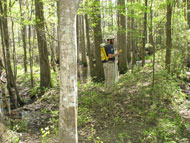Protecting and Sharing Our Cultural Heritage
Cultural resources are archaeological sites, historic buildings, cemeteries, battlefields, landscapes, historic structures, traditional cultural places, and objects. They are the threads that tie the present to the past to create a national fabric that represents who we are as individuals, as a state, and as a nation.
To protect our nation’s heritage, Congress passed laws and regulations that require all cultural resources on federal lands such as national parks, national forests, and military installations be protected and managed. Projects that use federal funds or require federal permits, such as highway constructions, also must abide by these laws. In the Lowcountry of South Carolina, cultural resources are protected by the Coastal Zone Management Act.
Cultural resource management services often are provided by private consulting firms that employ archaeologists, historians, and GIS specialists. Their job is to find and identify cultural resources, to evaluate the resources following the guidelines of the National Register of Historic Places, and to prepare a report about their research for the agencies in charge of protecting our heritage. In South Carolina, the South Carolina Department of Archives and History reviews archaeological reports prepared by management firms and decides which resources are important and should be protected.
Further Exploration
The South Carolina Department of Archives and History
www.scdah.sc.gov
African Diaspora Archaeology Network
www.diaspora.uiuc.edu
Lowcountry Digital Library
www.lowcountrydigital.library.cofc.edu
How to Evaluate and Nominate Designed Historic Landscapes
by Timothy and Genevieve Keller, US Department of the Interior, National Parks Services, Washington, D.C., 1994.
Uncommon Ground, Archaeology and Early African America 1650-1800
by Leland Ferguson, Smithsonian Books, Washington, D.C., 1992.
The Archaeology of Slavery and Plantation Life
by Theresa Singleton, Academic Press, Orlando, Florida, 1985.
Slave Counterpoint, Black Culture in the Eighteenth Century Chesapeake and Lowcountry
by Philip D. Morgan, University of North Carolina Press, 1998.
The Gullah People and Their African Heritage
by William S. Pollitzer, University of Georgia Press, Athens, 2005.
Sweetgrass Baskets and the Gullah Tradition
by Joyce Coakley, Arcadia Press, Charleston, 2005.
The Carolina Rice Kitchen: The African Connection
by Karen Hess, University of South Carolina Press, 1992.



